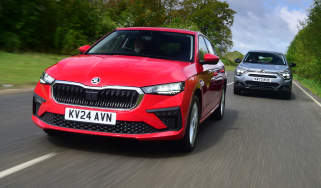Honda CR-V Advance long-term test: hybrid SUV ticks all the boxes
First report: we’re moving up in the world, from a Honda ZR-V to a CR-V
Verdict
As capable family transport, smart exec wheels or even as a workhorse, the latest Honda CR-V excels. The plug-in hybrid is better for Benefit-in-Kind tax breaks, but our regular hybrid is hard to fault nevertheless.
- Mileage: 8,583
- Economy: 39.1mpg
If I were a paying customer, I’d be on our local Honda dealer’s Xmas card list by now, having just graduated to my third Honda SUV fleet car in succession.
They’ve all been getting bigger too, with our new CR-V standing 53mm taller, 26mm wider, and 138mm longer than its ZR-V predecessor.
There are more obvious differences, of course, including the fact that our handsome new CR-V 2.0i-MMD Advance hybrid finished in lustrous Crystal Red Metallic (£995) has a boxier profile than its swoopier-looking ZR-V stablemate. This, combined with those extra inches all around, means it can load 579 ‘computer-simulated one-litre blocks’ in the boot even with the seats up. With its heavily raked rear hatch, the ZR-V musters a meagre 370 litres under the same test process, so while offering a decent amount of luggage room for the average family, it doesn’t get close to the CR-V’s capacity to swallow stuff.
This voracious appetite turned into a significant advantage when it came to the CR-V’s first major test, which was a 700-odd mile drive to Jena in Germany over Easter, to visit my partner’s family. We usually fly and agonise over what to pack in our suitcases, but taking the CR-V was liberating – after loading the kitchen sink, I thought ‘what the hell’ and chucked in my mountain bike as well. That still left room for the four cases of fine German lager I was ‘permitted’ to import on the return journey, as well as a couple of large cardboard boxes that, for reasons not fully explained to me, have now transitioned from a dusty basement in Germany to a dusty loft in Hampshire.
Using the Channel Tunnel, and stopping only for fuel, coffee, crisps and comfort breaks, the trip took roughly 13 hours each way. On the away and home legs we jumped out of the car at journey’s end feeling fresh and limber too, which is definitely a tribute to not only the seat comfort and cabin refinement of the CR-V, but also just how stress-free it is to drive. Adaptive cruise control and lane-keeping assistance can be a mixed blessing on crowded motorways here in the south east of England where you’re constantly forced to intervene, but they come into their own on a long European road trip when you can set the speed control to 80mph and enjoy long-ish periods of not having to contribute much to proceedings.
More reviews
Car group tests
In-depth reviews
Road tests
- Honda CR-V Advance Hybrid 2023 review
- Honda CR-V e:PHEV Advance 2023 review
- New Honda CR-V Hybrid 2019 review
Used car tests
The CR-V’s luxurious cabin pampered us on the journey, too. Honda describes this model as its “most premium family SUV yet”, and it’s certainly a decent step up from the ZR-V, which I felt could have done with a little more luxury to back up its premium-looking exterior styling.
Our CR-V is not only packed with tech and creature comforts, but it’s also very nicely trimmed in leather, with shiny highlights around the cabin that really enhance the ambience. I like it because it’s elegant and tasteful, without being overblown or frivolous, and also because the design and technology work so harmoniously, making the CR-V a rather fine thing to ‘own’.
Talking of spec, it’s worth giving you a run-down of what you can expect when spending close to £50,000 on a Honda these days. Aside from the soft leather upholstery, we’ve got an eight-way-adjustable driver’s seat with memory function, and seats that are heated for front and rear passengers, and cooled in the front. There’s a heated steering wheel, wireless charging, wireless Apple CarPlay (but not Android Auto, which requires a cable), and a nine-inch central touchscreen with Honda’s excellent Connect system for smartphone integration, punchy Bose music system, plus nav and vehicle settings. Yes, that’s a small screen by some standards, but I don’t like a massive telly in the living room either, so it’s right for me.
The CR-V’s digital dash is configurable, along with the head-up display, and there are sensible rotary switches for the climate control, plus an array of parking sensors that work with 360-degree cameras to make manoeuvring a breeze. There’s a panoramic glass roof, electric tailgate, very smart LED headlights with an effective anti-dazzle function, and 18-inch alloy wheels.
Safety and driving assistance functions are legion too, with a full spectrum of features, from traffic-sign recognition to intelligent speed control, a wide range of alerts and lane assistance.
The Honda’s kerbweight of a little more than 1,800kg means you get reasonable performance from the petrol/electric set-up, with 184bhp allowing a 0-62mph time of 9.5 seconds. Power delivery is smooth and refined, and while we achieved a decent 36mpg on our German run, driving locally often sees the economy rise to an even more pleasing 44mpg or more.
| Model: | Honda CR-V 2.0i-MMD Advance |
| On fleet since: | March 2024 |
| Price new: | £49,990 |
| Engine: | 2.0-litre 4cyl hybrid |
| CO2/tax: | 151g/km/£35% |
| Options: | Metallic paint (£995) |
| Insurance*: | Group: 34/Quote: £1,184 |
| Mileage: | 8,583 |
| Economy: | 39.1mpg |
| Any problems? | None so far |
*Insurance quote from AA (0800 107 0680) for a 42-year-old in Banbury, Oxon, with three points.







